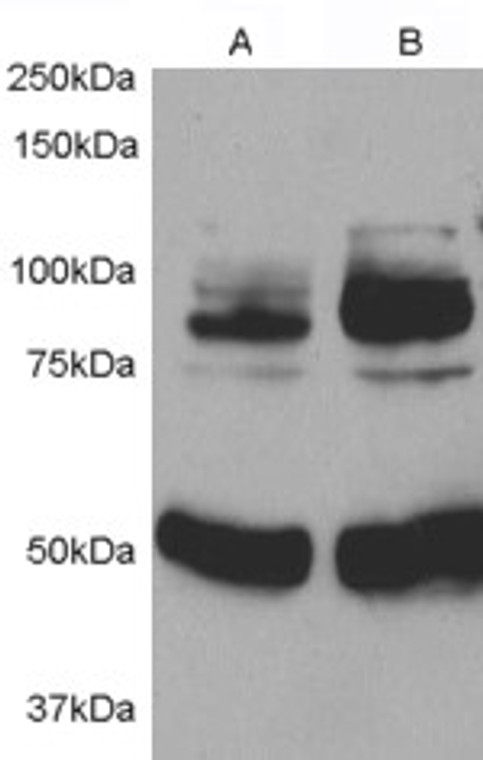| Host: |
Goat |
| Applications: |
Pep-ELISA/WB |
| Reactivity: |
Human/Mouse/Rat/Dog/Cow |
| Note: |
STRICTLY FOR FURTHER SCIENTIFIC RESEARCH USE ONLY (RUO). MUST NOT TO BE USED IN DIAGNOSTIC OR THERAPEUTIC APPLICATIONS. |
| Short Description: |
Goat polyclonal antibody anti-APPL1 (Internal) is suitable for use in ELISA and Western Blot research applications. |
| Clonality: |
Polyclonal |
| Conjugation: |
Unconjugated |
| Isotype: |
IgG |
| Formulation: |
0.5 mg/ml in Tris saline, 0.02% sodium azide, pH7.3 with 0.5% bovine serum albumin. NA |
| Purification: |
Purified from goat serum by ammonium sulphate precipitation followed by antigen affinity chromatography using the immunizing peptide. |
| Concentration: |
0.5 mg/mL |
| Dilution Range: |
ELISA-antibody detection limit dilution 1:64000. |
| Storage Instruction: |
Store at-20°C on receipt and minimise freeze-thaw cycles. |
| Gene Symbol: |
APPL1 |
| Gene ID: |
26060 |
| Uniprot ID: |
DP13A_HUMAN |
| Immunogen Region: |
Internal |
| Accession Number: |
NP_036228.1 |
| Immunogen Sequence: |
NRYSRLSKKRENDK |
| Post Translational Modifications | Phosphorylation at Ser-410 by PKA severely impairs binding to OCRL. |
| Function | Multifunctional adapter protein that binds to various membrane receptors, nuclear factors and signaling proteins to regulate many processes, such as cell proliferation, immune response, endosomal trafficking and cell metabolism. Regulates signaling pathway leading to cell proliferation through interaction with RAB5A and subunits of the NuRD/MeCP1 complex. Functions as a positive regulator of innate immune response via activation of AKT1 signaling pathway by forming a complex with APPL1 and PIK3R1. Inhibits Fc-gamma receptor-mediated phagocytosis through PI3K/Akt signaling in macrophages. Regulates TLR4 signaling in activated macrophages. Involved in trafficking of the TGFBR1 from the endosomes to the nucleus via microtubules in a TRAF6-dependent manner. Plays a role in cell metabolism by regulating adiponecting and insulin signaling pathways. Required for fibroblast migration through HGF cell signaling. Positive regulator of beta-catenin/TCF-dependent transcription through direct interaction with RUVBL2/reptin resulting in the relief of RUVBL2-mediated repression of beta-catenin/TCF target genes by modulating the interactions within the beta-catenin-reptin-HDAC complex. |
| Protein Name | Dcc-Interacting Protein 13-AlphaDip13-AlphaAdapter Protein Containing Ph Domain - Ptb Domain And Leucine Zipper Motif 1 |
| Database Links | Reactome: R-HSA-418889 |
| Cellular Localisation | Early Endosome MembranePeripheral Membrane ProteinNucleusCytoplasmEndosomeCell ProjectionRuffleCytoplasmic VesiclePhagosomeEarly Endosomal Membrane-Bound And NuclearTranslocated Into The Nucleus Upon Release From Endosomal Membranes Following Internalization Of Egf |
| Alternative Antibody Names | Anti-Dcc-Interacting Protein 13-Alpha antibodyAnti-Dip13-Alpha antibodyAnti-Adapter Protein Containing Ph Domain - Ptb Domain And Leucine Zipper Motif 1 antibodyAnti-APPL1 antibodyAnti-APPL antibodyAnti-DIP13A antibodyAnti-KIAA1428 antibody |
Information sourced from Uniprot.org
12 months for antibodies. 6 months for ELISA Kits. Please see website T&Cs for further guidance







